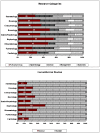Analysis of sex and gender-specific research reveals a common increase in publications and marked differences between disciplines
- PMID: 21067576
- PMCID: PMC2993643
- DOI: 10.1186/1741-7015-8-70
Analysis of sex and gender-specific research reveals a common increase in publications and marked differences between disciplines
Abstract
Background: The incorporation of sex and gender-specific analysis in medical research is increasing due to pressure from public agencies, funding bodies, and the clinical and research community. However, generations of knowledge and publication trends in this discipline are currently spread over distinct specialties and are difficult to analyze comparatively.
Methods: Using a text-mining approach, we have analysed sex and gender aspects in research within nine clinical subspecialties--Cardiology, Pulmonology, Nephrology, Endocrinology, Gastroenterology, Haematology, Oncology, Rheumatology, Neurology--using six paradigmatic diseases in each one. Articles have been classified into five pre-determined research categories--Epidemiology, Pathophysiology, Clinical research, Management and Outcomes. Additional information has been collected on the type of study (human/animal) and the number of subjects included. Of the 8,836 articles initially retrieved, 3,466 (39%) included sex and gender-specific research and have been further analysed.
Results: Literature incorporating sex/gender analysis increased over time and displays a stronger trend if compared to overall publication increase. All disciplines, but cardiology (22%), demonstrated an underrepresentation of research about gender differences in management, which ranges from 3 to 14%. While the use of animal models for identification of sex differences in basic research varies greatly among disciplines, studies involving human subjects are frequently conducted in large cohorts with more than 1,000 patients (24% of all human studies).
Conclusions: Heterogeneity characterizes sex and gender-specific research. Although large cohorts are often analysed, sex and gender differences in clinical management are insufficiently investigated leading to potential inequalities in health provision and outcomes.
Figures




References
Publication types
MeSH terms
LinkOut - more resources
Full Text Sources

